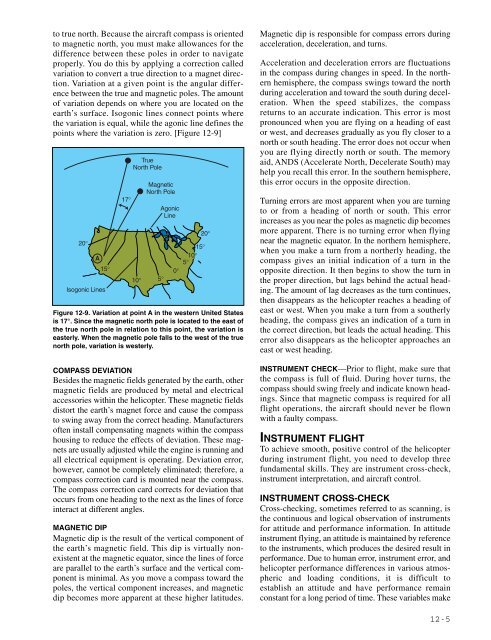Rotorcraft Flying Handbook, FAA-H-8083-21
Rotorcraft Flying Handbook, FAA-H-8083-21
Rotorcraft Flying Handbook, FAA-H-8083-21
You also want an ePaper? Increase the reach of your titles
YUMPU automatically turns print PDFs into web optimized ePapers that Google loves.
to true north. Because the aircraft compass is oriented<br />
to magnetic north, you must make allowances for the<br />
difference between these poles in order to navigate<br />
properly. You do this by applying a correction called<br />
variation to convert a true direction to a magnet direction.<br />
Variation at a given point is the angular difference<br />
between the true and magnetic poles. The amount<br />
of variation depends on where you are located on the<br />
earth’s surface. Isogonic lines connect points where<br />
the variation is equal, while the agonic line defines the<br />
points where the variation is zero. [Figure 12-9]<br />
20°<br />
A<br />
15°<br />
Isogonic Lines<br />
17°<br />
True<br />
North Pole<br />
Magnetic<br />
North Pole<br />
10° 5°<br />
Agonic<br />
Line<br />
COMPASS DEVIATION<br />
Besides the magnetic fields generated by the earth, other<br />
magnetic fields are produced by metal and electrical<br />
accessories within the helicopter. These magnetic fields<br />
distort the earth’s magnet force and cause the compass<br />
to swing away from the correct heading. Manufacturers<br />
often install compensating magnets within the compass<br />
housing to reduce the effects of deviation. These magnets<br />
are usually adjusted while the engine is running and<br />
all electrical equipment is operating. Deviation error,<br />
however, cannot be completely eliminated; therefore, a<br />
compass correction card is mounted near the compass.<br />
The compass correction card corrects for deviation that<br />
occurs from one heading to the next as the lines of force<br />
interact at different angles.<br />
MAGNETIC DIP<br />
Magnetic dip is the result of the vertical component of<br />
the earth’s magnetic field. This dip is virtually nonexistent<br />
at the magnetic equator, since the lines of force<br />
are parallel to the earth’s surface and the vertical component<br />
is minimal. As you move a compass toward the<br />
poles, the vertical component increases, and magnetic<br />
dip becomes more apparent at these higher latitudes.<br />
20°<br />
15°<br />
10°<br />
5°<br />
0°<br />
Figure 12-9. Variation at point A in the western United States<br />
is 17°. Since the magnetic north pole is located to the east of<br />
the true north pole in relation to this point, the variation is<br />
easterly. When the magnetic pole falls to the west of the true<br />
north pole, variation is westerly.<br />
Magnetic dip is responsible for compass errors during<br />
acceleration, deceleration, and turns.<br />
Acceleration and deceleration errors are fluctuations<br />
in the compass during changes in speed. In the northern<br />
hemisphere, the compass swings toward the north<br />
during acceleration and toward the south during deceleration.<br />
When the speed stabilizes, the compass<br />
returns to an accurate indication. This error is most<br />
pronounced when you are flying on a heading of east<br />
or west, and decreases gradually as you fly closer to a<br />
north or south heading. The error does not occur when<br />
you are flying directly north or south. The memory<br />
aid, ANDS (Accelerate North, Decelerate South) may<br />
help you recall this error. In the southern hemisphere,<br />
this error occurs in the opposite direction.<br />
Turning errors are most apparent when you are turning<br />
to or from a heading of north or south. This error<br />
increases as you near the poles as magnetic dip becomes<br />
more apparent. There is no turning error when flying<br />
near the magnetic equator. In the northern hemisphere,<br />
when you make a turn from a northerly heading, the<br />
compass gives an initial indication of a turn in the<br />
opposite direction. It then begins to show the turn in<br />
the proper direction, but lags behind the actual heading.<br />
The amount of lag decreases as the turn continues,<br />
then disappears as the helicopter reaches a heading of<br />
east or west. When you make a turn from a southerly<br />
heading, the compass gives an indication of a turn in<br />
the correct direction, but leads the actual heading. This<br />
error also disappears as the helicopter approaches an<br />
east or west heading.<br />
INSTRUMENT CHECK—Prior to flight, make sure that<br />
the compass is full of fluid. During hover turns, the<br />
compass should swing freely and indicate known headings.<br />
Since that magnetic compass is required for all<br />
flight operations, the aircraft should never be flown<br />
with a faulty compass.<br />
INSTRUMENT FLIGHT<br />
To achieve smooth, positive control of the helicopter<br />
during instrument flight, you need to develop three<br />
fundamental skills. They are instrument cross-check,<br />
instrument interpretation, and aircraft control.<br />
INSTRUMENT CROSS-CHECK<br />
Cross-checking, sometimes referred to as scanning, is<br />
the continuous and logical observation of instruments<br />
for attitude and performance information. In attitude<br />
instrument flying, an attitude is maintained by reference<br />
to the instruments, which produces the desired result in<br />
performance. Due to human error, instrument error, and<br />
helicopter performance differences in various atmospheric<br />
and loading conditions, it is difficult to<br />
establish an attitude and have performance remain<br />
constant for a long period of time. These variables make<br />
12-5

















